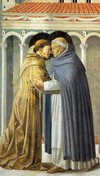Medieval Monasticism Flashcards
(11 cards)
1
Q
Cluniacs

(Congregation of Cluny)
A
- Early reform movement within Benedictine monasticism
- 10th-century origins, spreads widely in 11th and 12th centuries
- Associated with Abbey of Cluny in Burgundy, France
- Independent of local control by lay rulers
- Centralized structure with daughter houses; first monastic “order”
- Highly developed liturgy and masses for the dead
- “monks becoming priests”
2
Q
Cistercians

A
- reform movement within Benedictine monasticism
- origins in 12th-century eastern France (at Citeaux, hence Cistercian) and spread widely
- associated with Bernard of Clairvaux and his spirituality
- schola caritatis, or “school of love”
- opposed the luxury of Cluny, and returned to manual labour, prayer, austerity, and simplicity of Rule of St. Benedict
- adult recruitment only
3
Q
Augustinian Canons
Austin Canons or Canons Regular

A
- priests living in community under a rule, typically serving a church, a cathedral, or sometimes hospitals
- originated in the 11th century as part of reform movement
- began in northern Italy and southern France
- adopted a rule based on one drawn up earlier by St. Augustine; spread widely
- included influential independent congregations such as the Victorines or Premonstratensians
- “turning priests into monks”
4
Q
Mendicant Friars

A
- religious orders who did not own property in common (mendicant = “begging”)
- chiefly the Franciscans and Dominicans
- originate in late 12th and early 13th centuries in Italy
- no vow of stablity, free to itinerate
- extensive vernacular preaching ministry in towns
- “turning monks into preachers”
5
Q
Carthusians

A
- a strictly contemplative order of hermits
- originated in the late 11th and early 12th centuries
- established at the Grande Chartreuse or “charterhouse” in the Alps
- combined Benedictine community with ideals of the desert fathers
- claimed never to be reformed because never deformed
- The prior Guigo II wrote The Ladder of Monks**, an influential text on spiritual reading
6
Q
Bernard of Clairvaux

A
- 12th-century Abbot of Clairvaux in France
- Most influential founding Cistercian figure, supervising the early expansion of the order
- Influenced political and ecclesiastical affairs for a generation
- involved in controversy with Cluny over luxury and Abelard over idle intellectual “curiositas”
- preached the second crusade
- Wrote On Loving God and On the Song of Songs, classic works of mystical theology
- “saw reason and faith as fused in a single, intuitive loving act” (Rowan Williams)
7
Q
Hildegard of Bingen

A
- 12th-century German Abbess, monastic founder and writer
- Based on her visions, wrote Scivias (the ways of the Lord), a theological trilogy with a prophetic message for her times
- often ill with migraines, she produced a range of work in science, music, art and poetry, medicine, and other fields
- preached and interpreted Scripture
- corresponded with the leading figures of her period
8
Q
Francis of Assisi

A
- Founder of the Franciscan order (Friars Minor) in the 13th century in Umbria (Italy)
- embraced voluntary poverty and itinerant preaching; gathered a community to share in his mission
- with Clare, founded a similar order for women, the Poor Clares
- obtained recognition of his rule from Innocent III and successive popes
- established the first nativity scene or creche
- wrote the first vernacular Italian religious verse (All Creatures of our God and King); reflected his love of the created world
- preached to a Muslim sultan in Egypt
- “His generosity, his simple faith, his passionate devotion, his love of nature, and his deep humility have made him one of the most popular saints in modern times” (Oxford Dict. of the Christian Church)
9
Q
Dominic

A
- founder of the Dominican Order (Order of Preachers) in the 13th century
- From Spain, Dominic established the order in southwestern France; spread rapidly from there
- adopted and adapted the Augustinian rule
- initiated a new style of evangelization, preaching among communities vulnerable to heresy, emphasizing humility and poverty
- particular focus on cities and universities; advocated education to preach
10
Q
Catherine of Siena

A
- Medieval Italian mystic and Dominican tertiary
- 14th century
- Siena, Italy
- lived in a cell family home as “reclusa” or solitary
- called to abandon solititude, care for sick and poor, and convert sinners
- acted as mediator between rival local factions and in matters of high politics between papacy and Florence
- wrote Dialogues, where Christ-crucified is the bridge between earth and heaven
11
Q
Julian of Norwich

A
- Medieval English anchorite and mystic
- 14th and early 15th century
- Norwich, England
- near-death series of visions in May 1373
- wrote a short and long account of these: Showings or Revelation(s) of Divine Love
- within a vision of Christ’s passion, she saw the depth and breadth of God’s love
- “All shall be well, and all manner of things shall be well.”
- she had a vision of the universe as something as small as a hazelnut, held in God’s hand


